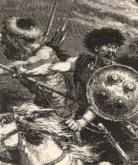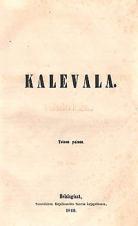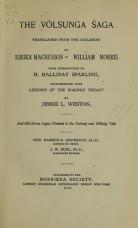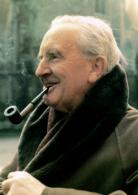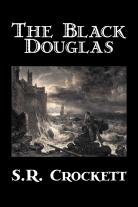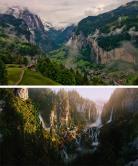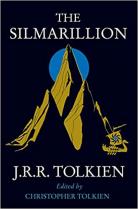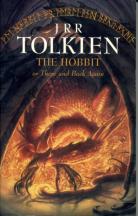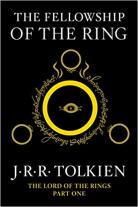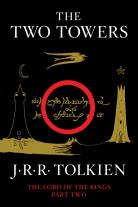Influences on Tolkien's Middle Earth
Created by Martina Caccia on Tue, 06/28/2022 - 16:37
Part of Group:
What are the influences of events, places and previous literature works on the Middle-Earth world? How “far” went Tolkien to create it?
The aim of this work is to show the events, places and previous literature works that had an influence on Tolkien's creation of Middle Earth.
Sources:
Carpenter, Humphrey, ed. 1981. The Letters of J. R. R. Tolkien. Houghton Mifflin.
Carpenter, Humphrey. 1978. J. R. R. Tolkien: A Biography. Unwin Paperbacks.
Shippey, Tom. 2005. The Road to Middle-Earth. Third ed. HarperCollins.
Solopova, Elizabeth. 2009. Languages, Myths and History: An Introduction to the Linguistic and Literary Background of J. R. R. Tolkien's Fiction. New York City: North Landing Books.
St. Clair, Gloriana. 1996. An Overview Of the Northern Influences on Tolkien's Works. Mythlore: A Journal of J.R.R. Tolkien, C.S. Lewis, Charles Williams, and Mythopoeic Literature, 21(2), pp. 63-67.
Wilkin, Peter. 2008. Norse Influences on Tolkien’s Elves and Dwarves. Sydney Studies in Religion, pp. 61-80.
Timeline
Chronological table
| Date | Event | Created by | Associated Places | |
|---|---|---|---|---|
| 20 Jun 451 |
Battle of the Catalaunian PlainsThe Battle of the Catalaunian Plains was a battle between a coalition of Romans and Visigoths against the Huns and their allies, commanded by their king Attila. Tolkien has referred multiple times to a historic account of the Battle of the Catalaunian Plains by Jordanes, and analyses the two battles' similarities. Both battles take place between civilisations of the "East" and "West", both authors described the battles as one of legendary fame that lasted for several generations. Moreover, the death of king Theodoric I on the Catalaunian Fields and that of Théoden on the Pelennor share some common features. Jordanes says that Theodoric was thrown off by his horse and trampled to death by his own men who charged forward. In a similar way, Théoden rallies his men shortly before he falls and is crushed by his horse. |
Martina Caccia | ||
| circa. 975 to circa. 1025 |
Writing of BeowulfBeowulf is an Old English epic poem written by an anonymous author. Beowuls is a hero of the Geats that helped Hrothgar, king of the Danes, in defeating the monster Grendel, who attacked the Hall of Heorot. After Beowulf killed the monster, Grendel's mother attacks the hall and is also defeated. Victorious, Beowulf goes home and becomes king. Fifty years later, Beowulf defeats a dragon, but is mortally wounded in the battle and later died. First of all Tolkien, as an expert of Old English, used the expertise on Beowulf to create some of the races of Middle-earth such as "eotenas ond ylfe ond orcnéas", which were his orcs and elves. The Beowulf dragon can be compared to the dragon in The Hobbit, Smaug. The Beowulf dragon is aroused and enraged when a golden cup from his pile of treasure is stolen; then he flies out in and destroys Beowulf's hall; he is killed, but the treasure is cursed, and Beowulf too dies. In The Hobbit, Bilbo Baggins steals a golden cup from the dragon's treasure, awakening Smaug, who flies out and burns Lake-town; the allure of gold is too much of a temptation for the Dwarf Thorin Oakenshield, who is killed afterwards by an orc. |
Martina Caccia | ||
| circa. 1200 |
Production of the Poetic Edda and the Prose EddaThe Prose Edda, written by Snorri Sturluson (1179-1241), is one of the main sources of Norse mythology in Icelandic literature. Then there is the Poetic (or Elder) Edda, a source used by Snorri in the creation of his Edda, compiled around the 1270s by an anonymous writer. It contains mythological information of the period before the conversion to Christianity. Both sources were relevant to Tolkien: here can be found the earliest accounts of elves and dwarves. In the Poetic Edda we found sixteen dwarves names that are also present in The Hobbit and from the Prose Edda we receive two additional names. Moreover, the typical dwarf characteristics such as short stature with long beards, love for treasure, skill as smiths, and bad temper comes from the Eddas. In one of his letter to his son Christopher, Tolkien called Gandalf “Odinic wanderer”, one of the deities of the Norse mythology. Furthermore, all the wizards seem to have some characteristics who link them to Norse gods: Gandalf from Odin, Saruman from Loki, Radagast from the God Frey. |
Martina Caccia | ||
| circa. 1835 |
The epic poem Kalevala is publishedOne of the greatest influence on Middle-Earth is the Finnish epic Kalevala, in particular the tale of Kullervo. Similarities can be seen in the tale of Túrin Turambar: both are tragic heroes, commit incest with their sister who then kills herself after discovering it and both heroes kill themselves. If in The Lord of the Ring the events are centred around the One Ring, in the Kalevala we have the magical item called Sampo, which provide its owner with great fortune but never makes clear its nature. The Sampo and the One Ring have a similar story: both are cause of the fight between the forces of good and evil and are destroyed nearly at the end of the story. The Kavala main charcater Väinämöinen shares with Gandalf immortal origins and wise nature and at the end they departure on a ship to lands beyond the mortal world. The Finnish language was also used by Tolkien as a base for the Quenya Elvish language. |
Martina Caccia | ||
| 1870 |
First English translation of the Völsunga sagaThe Völsunga saga is a legendary saga based on the origin and decline of the Völsung clan. When Tolkien was a student, the only way of reading it in English was through the translation of 1870 made by William Morris and Eirikur Magnusson. The most relevant events in the Völsunga saga are the quest led by Sigmund and Sinfjötli to save princess Signy from the king Siggeir, Sigurd killing the serpent/dragon Fafnir; and the influence of the cursed ring Andvaranaut. The similarities with Tolkien works can be seen in the figure of dragon (Fafnir vs Smaug) and the cursed ring Andvaranaut, which resembles the One Ring (both are cursed and magical golden ring). Moreover, in the saga we have a broken sword reforged called Gram. Also in The Lord of the rings there is a broken sword reforged, Andúril. |
Martina Caccia | ||
| 3 Jan 1892 |
Birth of J.R.R. TolkienJohn Ronald Reuel Tolkien was born in Bloemfontein, South Africa, on the 3rd of January 1892.
Son of Arthur Tolkien, a bank clerk who moved to South Africa in the 1890s in the prospect of achieving a promotion, and Mabel Suffield. He also had a brother, Hilary, born on the 17th of February 1894. During his childhood in Africa, Tolkien was bitten by a spider. Many scholar believed that this event had an influence in the creation of the spiders of Middle Earth (Shelob and Ungoliant), but the author denied, sayng that he actually had no memory of this event. At the age of three, he moved to England with his mother and brother. Later, they should have joined by his father. However, Arthur Tolkien died in South Africa due to rheumatic fever in 1896. |
Martina Caccia | ||
| 1899 |
Publication of The Black DouglasThe Black Douglas is a historical fantasy novel written by Samuel Rutherford Crockett. Set in Scotland and France in the fifteenth century, it has both historical and supernatural elements. Historical figures include William Douglas and Gilles De Retz, while supernatural elements present in the novel are the werewolves. Tolkien might have been influenced in the following writing choices in the Lord of the Rings: - the battle with the wargs in The Lord of the Rings was inspired by the battle with werewolves (as he confirmed in a letter); - the character of Gilles De Retz might have influenced the dark lord Sauron; - Sholto's secret mail-coat could resemble Frodo's mithril coat. |
Martina Caccia | ||
| Summer 1911 |
Trip to the Lauterbrunnen Valley, in SwitzerlandIn the summer of 1911, Tolkien participated in a walking holiday in Switzerland, which have inspired his descriptions of the Misty Mountains and of Rivendell. «I am.... delighted that you have made the acquaintance of Switzerland, and of the very part that I once knew best and which had the deepest effect on me. The hobbit's (Bilbo's) journey from Rivendell to the other side of the Misty Mountains, including the glissade down the slithering stones into the pine woods, is based on my adventures in 1911: the annus mirabilis of sunshine in which there was virtually no rain between April and the end of October, except on the eve and morning of George V's coronation. (Adfuit Omen!)» (Letter 306 - to his son, 1967) |
Martina Caccia | ||
| Jul 1916 to Nov 1916 |
Battle of the SommeTolkien wrote in a letter in 1960 that "The Dead Marshes [a place north of Mordor] and the approaches to the Morannon [an entrance to Mordor] owe something to northern France after the Battle of the Somme". He took part in the battle between September and October 1916 as a signals officer, before being sent home with trench fever. According to many scholar, the metallic dragons that attack the Elves in the final battle of The Fall of Gondolin can be seen as tanks. |
Martina Caccia | ||
| circa. Nov 1917 |
Tolkien starts writing "The Silmarillion"After months in and out of the trenches, Tolkien succumbed to "trench fever" and was sent back to England in November. He spent the next month in hospital in Birmingham and by Christmas he had recovered. During the war many of his friends of the “Tea Club, Barrovian Society” had been killed in action. As an act to remember them but also to react against the war experiences, he had begun to write his stories. This ordering of his imagination developed into the Book of Lost Tales, in which most of the major stories of the Silmarillion appear in their first form: tales of the Elves and the “Gnomes”, with their languages Qenya and Goldogrin, the first recorded versions of the wars against Morgoth, the siege and fall of Gondolin and Nargothrond, and the tales of Túrin and of Beren and Lúthien. |
Martina Caccia | ||
| 21 Sep 1937 |
Publication of "The Hobbit"One day, when Tolkien was marking examination papers, he discovered that one candidate had left one page of an answer-book blank and here he wrote “In a hole in the ground there lived a hobbit“. After that he decided to find out what a Hobbit was, what sort of a hole it lived in, why it lived in a hole, etc. From this investigation a story was born. In 1936 an incomplete typescript of it attived in the hands of Susan Dagnall, an employee of the publishing firm of George Allen and Unwin. She asked Tolkien to finish it, and presented the complete story to Stanley Unwin, Chairman of the firm. He read it to his son, who wrote an approving report, and it was published as The Hobbit in 1937. |
Martina Caccia | ||
| 29 Jul 1954 |
Publication of "The Fellowship of the Ring"First of the three books that made up the epic novel The Lord of the Rings. Tolkien spent many years in writing it (more than ten years according to his biography). According to Tolkien, it should have been a children's story as The Hobbit, but soon became darker and serious in the writing. Also the audience was different: it was not intended for children but for an older audience, drawing on other stories that later will be seen in The Silmarillion. |
Martina Caccia | ||
| 11 Nov 1954 |
Publication of "The Two Towers"The second book of "The Lord of the Rings" series is published. |
Martina Caccia | ||
| 20 Oct 1955 |
Publication of "The Return of the King"The third book of "The Lord of the Rings" series is published. |
Martina Caccia |

